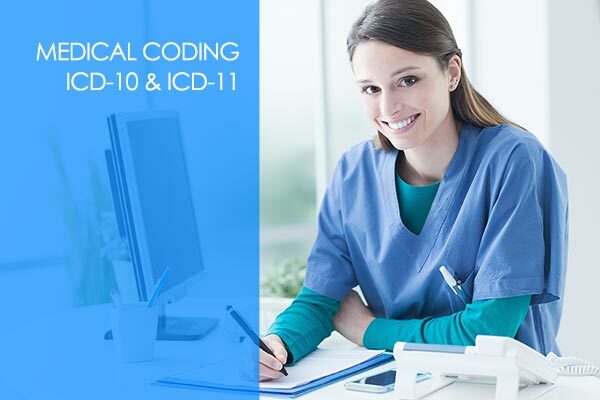Medical Billing and Coding (ICD-10 and ICD-11) – 100% Online
This online medical billing and coding course covers medical terminology, knowledge of body systems, and how to select the correct diagnosis and procedure codes. This course will also teach you how to complete billing guidelines needed to submit claims to insurance companies and receive payment. This course covers the objectives needed to pass the ICD 10 and ICD 11 certification exam.
Included In This Course



Closed Captions



Certificate of Completion
Become An Expert With Our Medical Billing and Coding Online Training.
Our online medical billing and coding course is designed to provide comprehensive training that covers all the essentials. This course is perfect for those looking for medical billing and coding classes online, as it includes 20 training hours, 58 on-demand videos, and a certificate of completion.
As a Certified Coding Specialist (CCS), you’ll gain expertise in medical billing and coding ICD-10 & ICD-11. This online medical billing and coding class covers the objectives needed to pass the ICD-10/11 certification exam, making it one of the best online schools for medical billing and coding.
Our medical billing and coding online courses include modules on Anatomy, Diagnosis Coding, Procedure Coding, and Billing Guidelines and Practices. These modules are essential for anyone interested in medical billing and coding online programs. You’ll learn how to assign precise codes to diagnoses, procedures, or services that healthcare providers offer, making you an invaluable asset in the healthcare industry.
Whether you’re looking for low-cost medical coding and billing online programs or a comprehensive online class for medical coding and billing, our course has you covered. With hands-on practice and real-life coding examples, this course lays the groundwork for successful medical billing and coding, making it one of the best online courses for medical billing and coding.
By the end of this online medical billing and coding course, you’ll have the skills to enter one of the fastest-growing fields as a Certified Coding Specialist. Enroll now to start your journey in the healthcare field with our medical billing and coding online classes.
Online Medical Coding and Billing Course Includes
- Copies of all slides used in course
- Flashcards
- Practice exam questions/test
- Earning a certificate of completion is your first step to becoming a Medical Coding Specialist
Instructor
Wendy Bell Our Complete Anatomy, ICD, CPT, and Medical Billing course encompasses everything Medical Coder students need to know to successfully pass the test required to secure relevant employment in the healthcare field and become a Medical Coding Specialists.
Description of Medical Coding and Billing and Clinical Concepts
This online medical billing and coding course provides students with crucial information about medical terminology, body systems, correct diagnosis, and procedure codes. It also includes cluster coding and billing guidelines for submitting to insurance companies. Our medical coding and billing online courses are designed to give Medical Coder students experience with the ICD-10-CM Code set and ICD-11 codes, enhancing their chances of securing job opportunities in the healthcare industry.
If you’re looking for medical billing and coding online schools that offer comprehensive training, you’ve come to the right place. This course lays the groundwork for successful medical billing and coding. Anatomy and Medical Terminology are among the foundations, providing you with the right foundational building blocks to produce accurate codes and avoid errors. This makes our program one of the best online schools for medical billing and coding. Below are the primary topics covered in the comprehensive online training.
Module 1: Anatomy
In this foundational module of our online medical billing and coding course, you’ll dive deep into the anatomy of the human body. Topics range from skin and bones to the intricate workings of the heart and blood vessels. This module is essential for anyone looking to take medical billing and coding classes online, as a strong understanding of anatomy is crucial for accurate coding.
Topics Covered:
- Introduction to Human Body
- Skin, Bones, Muscles, and Joints
- Cardiovascular System: Heart and Blood Vessels
- Respiratory System: Lungs
- Gastrointestinal System: Stomach, Intestines, and Colon
- Renal System: Kidney, Bladder, Prostate, etc.
- Reproductive System: Uterus, Ovaries, and Female Parts
- Visual System: Eye
- Endocrine System: Glands
- ENT: Ear, Nose, and Throat
- Hematology: Blood
- Immunology: Immune System
- Neurology: Brain and Spinal Cord
Module 2: Diagnosis Coding
This module focuses on diagnosis coding, a key component of our medical billing and coding online programs. You’ll learn about the ICD coding system and how to apply it across a range of medical conditions, from infectious diseases to mental health issues.
Topics Covered:
- Overview of ICD
- Outpatient Guidelines
- Infectious and Parasitic Diseases
- Neoplasms
- Diseases of the Blood and Blood Organs
- Endocrine, Nutritional, and Metabolic Diseases
- Mental and Behavioral Health
- Pregnancy, Childbirth, and the Puerperium
- Conditions Originating in Perinatal Period
- Symptoms, Signs, and Abnormal Clinical and Laboratory Findings
- Injury, Poisoning, and Certain Other External Causes
- Diseases of the Skin and Subcutaneous Tissue
- External Causes of Morbidity
- Factors Influencing Health
- Circulatory System
- Eye
- Respiratory
- Digestive
Module 3: Procedure Coding
In this module, you’ll explore the various aspects of procedure coding, making this one of the best online medical billing and coding courses for comprehensive learning. From evaluation and management to surgery and radiology, this module covers it all.
Topics Covered:
- Evaluation and Management (Parts 1-4)
- Anesthesia
- Modifiers
- Surgery (Parts 1-3)
- Radiology
- Pathology
- OB/GYN
- Physical Medicine (Parts 1-2)
- HCPCS
- Diving Into Coding (Parts 1-3)
- NCCI, MUE, and GME
- CAT Codes
Module 4: Billing Guidelines and Practices
The final module of our medical billing and coding certification online course covers the essential billing guidelines and practices. You’ll learn about HIPAA, compliance, and how to navigate the reimbursement process, making you fully equipped for a career in medical billing and coding online.
Topics Covered:
- HIPAA, Compliance, and Reimbursement (Parts 1-4)
- The Next Steps
These module descriptions are designed to provide a comprehensive overview while integrating your focused keywords. Let me know if you’d like to make any further adjustments or have additional questions!
Completing the course to become a Certified Coding Specialist will give you valuable knowledge.
- Demonstrate knowledge of function and structure of the human body
- Understand common disorders that occur within various body systems for diagnostic coding
- Understand and apply diagnostic for ICD-10 coding and ICD-11 coding
- Understand and apply procedure coding (CPT)
- Understand the use of appropriate modifiers and impact on clinical documentation
- Apply billing concepts used to pay claims and work insurance denials
- Creating and using code clusters for electronic health records accurately and efficiently
- Update and maintain medical records while reducing ICD-10 coding and ICD-11 Coding errors
Medical Coding and Billing is intended for any student who wishes to enter the healthcare field or improve skills needed to receive accreditation to become a medical coder as a Certified Coding Specialist.
You May Also Like
HIPAA Training and Its Importance in Today’s Environment
What is HIPAA Training? HIPAA training, also known as HIPPA training, refers to the education and awareness programs that healthcare organizations and professionals undergo to ensure compliance with the Health Insurance Portability and Accountability Act (HIPAA).
Understanding Workplace Harassment: A Comprehensive Guide
Introduction Workplace harassment is an issue that affects millions of people every year, impacting their well-being and job performance. Understanding the different forms of harassment and how to prevent them is crucial for both employees and employers. In this comprehensive guide, we’ll delve into the topic and offer actionable insights.
Key Term Knowledge Base: Key Terms Related to Medical Coding and Billing (ICD-10 and ICD-11)
Understanding key terms in medical coding and billing, especially concerning ICD-10 and ICD-11, is crucial for professionals in the healthcare industry. This knowledge not only aids in accurate and efficient medical coding but also ensures compliance with legal and regulatory requirements. It’s essential for medical coders, billers, and other healthcare professionals to be familiar with these terms to maintain the integrity and continuity of medical records and billing processes.
| Term | Definition |
|---|---|
| ICD-10 | The International Classification of Diseases, 10th Revision, a medical classification list by the World Health Organization (WHO) for coding diseases, signs and symptoms, abnormal findings, etc. |
| ICD-11 | The 11th Revision of the International Classification of Diseases, providing a significant update to the ICD-10, including new chapters and major structural changes. |
| Coding | The process of translating medical diagnoses and procedures into universal medical code numbers. |
| Billing | The process of submitting and following up on claims with health insurance companies to receive payment for services rendered by a healthcare provider. |
| CPT (Current Procedural Terminology) | A set of codes, descriptions, and guidelines used to describe medical, surgical, and diagnostic services. |
| HIPAA (Health Insurance Portability and Accountability Act) | United States legislation that provides data privacy and security provisions for safeguarding medical information. |
| CCS (Certified Coding Specialist) | A professional certification for individuals specialized in coding patient records for billing purposes. |
| Modifiers | Codes used in medical billing to report or indicate that a service or procedure has been altered by some specific circumstance but not changed in its definition. |
| HCPCS (Healthcare Common Procedure Coding System) | A set of codes used for billing and coding of medical procedures and services. |
| Diagnosis Coding | Assigning codes to diagnoses based on the ICD system. |
| Procedure Coding | Assigning codes to medical procedures performed, typically using CPT or HCPCS codes. |
| Compliance | Adhering to laws, regulations, guidelines, and specifications relevant to the healthcare industry. |
| EHR (Electronic Health Records) | Digital version of a patient’s paper chart, used to collect and store patient health information electronically. |
| Reimbursement | The process by which health insurance companies or government programs pay healthcare providers for their services. |
| Outpatient | A patient who receives medical treatment without being admitted to a hospital. |
| Neoplasms | Abnormal growth of tissue, commonly referred to as tumors, which can be cancerous or noncancerous. |
| Anesthesia Coding | Coding the services provided by anesthesiologists or CRNAs during surgical procedures. |
| Medical Terminology | The specific language used in the healthcare field to describe the body, its functions, diseases, procedures, and treatments. |
| NCCI (National Correct Coding Initiative) | A CMS initiative to prevent improper coding and combat fraud and abuse in coding and billing. |
| MUE (Medically Unlikely Edits) | A Medicare policy that places limits on the frequency of services rendered or items furnished to a patient. |
| GME (Graduate Medical Education) | A set of educational activities that prepare medical graduates for practice in their chosen field. |
| CAT Codes | Category Codes used in medical coding, which are sets of procedural codes related to a specific category of service or treatment. |
| Pathology Coding | Coding for laboratory testing and analysis of tissue, cell, and body fluid samples. |
| Evaluation and Management Coding | Coding for non-surgical services that assess and manage a patient’s health. |
| Radiology Coding | Coding for imaging services, such as X-rays, MRIs, and CT scans. |
| Surgery Coding | Coding for surgical procedures across various medical specialties. |
| OB/GYN Coding | Coding for obstetric and gynecological services. |
| Physical Medicine Coding | Coding for rehabilitation therapies and physical medicine services. |
| Infectious Diseases | Diseases caused by pathogenic microorganisms, such as bacteria, viruses, parasites, or fungi. |
| Endocrine Diseases | Disorders related to the endocrine system, which involves hormones and glands. |
| Mental and Behavioral Health Coding | Coding for psychiatric and psychological conditions and treatments. |
| Respiratory System Coding | Coding for diseases and treatments related to the lungs and respiratory system. |
| Digestive System Coding | Coding for diseases and treatments related to the gastrointestinal tract. |
| Hematology Coding | Coding for diseases and treatments related to blood and blood-forming organs. |
| Immunology Coding | Coding for diseases and treatments related to the immune system. |
| Neurology Coding | Coding for diseases and treatments related to the nervous system, including the brain and spinal cord. |
| ENT Coding | Coding for ear, nose, and throat conditions and treatments. |
| Dermatology Coding | Coding for skin-related conditions and treatments. |
| Urology Coding | Coding for diseases and treatments related to the urinary system and male reproductive organs. |
| Pediatrics Coding | Coding for medical services provided to infants, children, and adolescents. |
| Geriatrics Coding | Coding for medical services provided to elderly patients. |
| Ophthalmology Coding | Coding for diseases and treatments related to the eye and vision. |
| Cardiology Coding | Coding for diseases and treatments related to the heart and cardiovascular system. |
| Oncology Coding | Coding for cancer-related diagnoses and treatments. |
| Rheumatology Coding | Coding for diseases and treatments related to joints, muscles, and bones. |
| Endoscopy Coding | Coding for endoscopic procedures, which involve examining the interior of a bodily organ or cavity. |
| Emergency Medicine Coding | Coding for services provided in an emergency department or for urgent medical conditions. |
This comprehensive list provides an overview of the essential terms and concepts in medical coding and billing, particularly in the context of ICD-10 and ICD-11. Familiarity with these terms can greatly enhance the understanding and efficiency of professionals working in this field.
Frequently Asked Questions About Medical Billing and Coding (ICD-10 and ICD-11)
What is the purpose of this course and who can enroll?
This online course provides comprehensive training on medical terminology, knowledge of body systems, and how to correctly select diagnosis and procedure codes. It also covers billing guidelines for submitting claims to insurance companies. The course is designed for anyone who wishes to enter the healthcare field or improve their skills to become a certified medical coder as a Certified Coding Specialist.
What will I gain from this course?
Upon completion of the course, you will have acquired a wide range of knowledge and skills. You will understand common disorders that occur within various body systems for diagnostic coding, understand and apply diagnostic for ICD-10 coding and ICD-11coding, understand and apply procedure coding (CPT), and be able to create and use code clusters for electronic health records accurately and efficiently, among other skills. These will be valuable for your career in medical coding and billing.
What materials and resources will be provided during the course?
The course includes copies of all slides used, flashcards, and practice exam questions. You will also gain access to diagrams, charts, and hands-on practice with coding examples from real-life scenarios. These resources are designed to support your learning and prepare you for the certification exam.
Who is the instructor for this course?
The course is led by Wendy Bell, a certified coder with accreditation through the AAPC. Wendy has over twenty years of experience in healthcare, and she has worked in multiple specialties. She continues to work in the field as a consultant, helping providers identify and resolve cash flow problems.
How is the course structured?
The course is divided into four main modules: Anatomy, Diagnosis Coding, Procedure Coding, and Billing Guidelines and Practices. Each module covers a variety of topics relevant to medical coding and billing. For instance, the Anatomy module discusses different body systems, while the Diagnosis Coding module provides an overview of ICD coding and diseases relevant to different body systems. The Procedure Coding module focuses on evaluation and management, surgery, radiology, and more, and the Billing Guidelines and Practices module covers important billing procedures.
What is the final outcome of this course?
The course prepares you for the ICD-10/11 certification exam. After successful completion, you will earn a certificate of completion, which is your first step to becoming a Medical Coding Specialist. As a Certified Coding Specialist, you will be able to assign precise codes to diagnoses, procedures, or services that healthcare providers offer, making you an invaluable asset to healthcare providers and insurance companies.
Blogs of Interest Related to This Course
- Upgrading Your Skills with ICD 11 Training: What You Need to Know
- Training for Medical Billing and Coding : Training for ICD 10 and ICD 11
- Medical Billing and Coding : A 101 Guide and Roadmap to Success
- Coding License : The Path to Becoming a Certified Professional Coder
- How Long to Get Certified in Medical Coding : Steps and Timeline
- Medical Billing and Coding Job Description : What to Expect in Your Role as a Specialist
- Medical Coding Practice Examples : The Ultimate List of Billing and Coding Examples
- Medical Billing Coding from Home : Opportunities and How to Seize Them
- Medical Billing Overview : An Introduction to Medical Billers and Their Role
- Medical Billing Specialist Requirements : Your Comprehensive Guide to Becoming a Medical Biller
Proudly DisplayYour Achievement
Upon completion of your training, you’ll receive a personalized certificate of completion to help validate to others your new skills.
ICD 10 & 11 Medical Coding and Billing Course Content
Module 1: Anatomy
- Module 1 Workbook
- 1.1 Introduction
- 1.2 Human Body
- 1.3 Skin
- 1.4 Bones, Muscles and Joints
- 1.5 Heart and Blood Vessels
- 1.6 Lungs
- 1.7 Stomach, Intestines and Colon
- 1.8 Kidney, Bladder, Prostate and More
- 1.9 Uterus, Ovaries and Female Parts
- 1.10 Eye
- 1.11 Glands
- 1.12 Ear, Nose and Throat
- 1.13 Blood
- 1.14 Immune
- 1.15 Brain and Spinal Cord
Module 2: Diagnosis Coding
- Module 2 Workbook
- 2.1 Overview of ICD
- 2.2 Outpatient Guidelines
- 2.3 Infectious and Parasitic
- 2.4 Neoplasms
- 2.5 Diseases of the Blood and Blood Organs
- 2.6 Endocrine, Nutritional and Metabolic Diseases
- 2.7 Mental and Behaviroal Health
- 2.8 Pregnancy, Childbirth and the Puerperium
- 2.9 Conditions Originating in Perinatal Period
- 2.10 Symptoms, Signs and Abnormal Clinical and Laboratory Findings
- 2.11 Injury, Poisoning and Certain Other External Causes
- 2.12 Diseases of the Skin and Subcutaneous Tissue
- 2.13 External Causes of Morbidity
- 2.14 Factors Influencing Health
- 2.15 Circulatory System
- 2.16 Eye
- 2.17 Respiratory
- 2.18 Digestive
Module 3: Procedure Coding
- Module 3 Workbook
- 3.1 Evaluation and Management part 1
- 3.1 Evaluation and Management part 2
- 3.1 Evaluation and Management part 3
- 3.1 Evaluation and Management part 4
- 3.2 Anesthesia
- 3.3 Modifiers
- 3.4 Surgery part 1
- 3.4 Surgery part 2
- 3.4 Surgery part 3
- 3.5 Radiology
- 3.6 Pathology
- 3.7 OB/GYN
- 3.8 Physical Medicine part 1
- 3.8 Physical Medicine part 2
- 3.9 HCPCS
- 3.10 Diving Into Coding part 1
- 3.10 Diving Into Coding part 2
- 3.10 Diving Into Coding part 3
- 3.11 NCCI, MUE and GME
- 3.12 CAT Codes
Module 4: Billing Guidelines and Practices
- Module 4 Workbook
- 4.1 HIPAA, Compliance and Reimbursement part 1
- 4.1 HIPAA, Compliance and Reimbursement part 2
- 4.1 HIPAA, Compliance and Reimbursement part 3
- 4.1 HIPAA, Compliance and Reimbursement part 4
- 4.2 The Next Steps
| 5 star | 81 | 81% |
| 4 star | 18 | 18% |
| 3 star | 1 | 1% |
| 2 star | 0% | |
| 1 star | 0% |
Sorry, no reviews match your current selections
Your Training Instructor
Wendy Wendy is a certified coder with accreditation through AAPC. She has worded in healthcare for twenty plus years and has worked in multiple specialties such as Radiology, family practice, chiropractic, OB/ Gyn, Orthopedics and more. She has been an active member of her local AAPC chapter and served as Vice President and Member Education roles. Wendy not only educates; she continues to in the field daily as a consultant to help providers find cash flow problems and get them resolved quickly.
Personally, she lives in Naples, Maine during the summer months and Florida in the winter, giving her the best of both worlds. She has two grown daughters and a sweet granddaughter. In her free time she enjoys camping, travel and a giant Patriots fan .

Subscribe To All-Access
Lock In $16.99 / Month Forever
Access this course and over 2,700 hours of focused IT training. Start your first month for only $1.00. Then lock in only $16.99 / month for life.
- Get Every Course
- Free Updates / New Content Added
- 2,700+ Hours of Training
- Price Lock Guarantee
- Games / Flashcards
- 21,000+ Practice Questions
$49.99 $16.99 Monthly
$89.00 Original price was: $89.00.$29.00Current price is: $29.00.







I haven’t made it through the complete course but after making it through the anatomy, Wendy needs to work on her pronunciation of the medical terms. I am a certified X-ray tech and she mispronounced SO many terms. Thankfully, I know better but as someone who doesn’t have a medical background, she going to seriously confused someone. I believe the course might be a little outdated as well. I understand the course is cheap but we are still paying to learn.
good